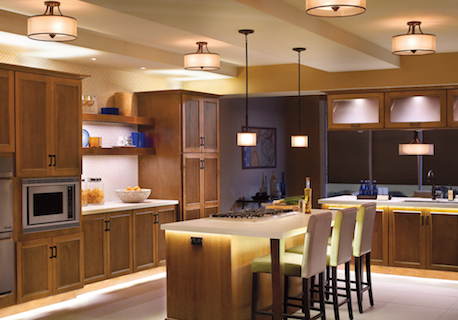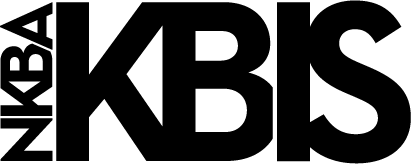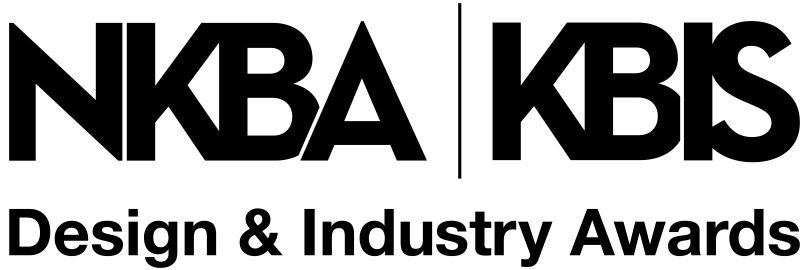Good-looking and effective lighting can be as simple as 1, 2, 3. Applying three layers of light in any room of the house solves even the toughest of lighting challenges.
1. Ambient/general lighting: Ambient light becomes the foundational level upon which the other layers are built.
2. Task lighting: Task lighting aids in the performance of the task in the room.
3. Accent/decorative lighting: Accent lighting is like the jewelry, the “bling” that aesthetically finishes the room.
IN THE KITCHEN
Ambient light should be defined first and should be provided in an even amount around the room. In most kitchens, this is done through recessed lighting, but to add visual interest, semi-flush fixtures can be an effective option. In terms of lamping, there are no hard and fast rules, but increasingly fixtures are being introduced that use LEDs. These include LED-based recessed lighting, which can be quite good but also expensive. Semi-flush fixtures typically employ incandescents, which can be easily replaced with more energy-efficient compact fluorescents (CFLs). Whatever the source you—or your client—choose to use, make sure you provide enough ambient lighting. The Illuminating Engineering Society (IES) recommends between 30 to 40 fc of general light in a kitchen.
In the kitchen, where the primary function is food preparation, task lighting is typically undercabinet light that supplements the ambient lighting by increasing the lumen intensity on the counters. It typically uses one of three light sources—xenon, fluorescent and more recently, LED—with the choice often determined by cost. In addition, many of today’s ventilation hoods come equipped with halogen lighting to illuminate the cooktop or range, and for kitchens that include a home office, task lighting can also take the form of a desk lamp. For safety and functionality, undercabinet lighting may be the most important light included in a kitchen and therefore requires sufficient brightness. The IES recommends a measured 75 to 100 fc on a counter surface.
Last, but probably of most importance to the overall look of the room, is accent or decorative lighting. This may be over-cabinet, inside-cabinet, toekick and/or undercounter lighting or any other type of architectural detail illumination, such as that placed in tray ceilings and behind cove molding. For use in small spaces, such as toekicks and coves, many of today’s fixtures are transitioning to LEDs, which are easier to conceal and whose long lamp life means less frequent relamping. Accent lighting is not needed for function, but makes a good design great and a great design perfect. It is the element that makes friends and neighbors take notice.
IN THE BATH
Good task lighting in the bath is the most important design requirement. The primary tasks in a bathroom are shaving or make-up application, so task lighting is positioned around the mirror. If you have one choice in illuminating a bathroom, place one fixture on each side of the mirror. This will provide light from two directions, and the shadows that naturally occur with one direction light will dissipate. If you have the option, also add a light from above. Light from three directions will virtually eliminate shadows and make the tasks, such as applying make-up and grooming, simpler and easier.
In smaller bathrooms, where it is not uncommon for one layer of light to do double duty, the task light may also serve as ambient illumination. Larger bathrooms, however, may require adding some ambient light in the center of the room or throughout the space. Of course, the bigger the room, the more light it will need.
Finally, accent lighting should not be ignored in the bath, be it a miniature chandelier over the soaking tub or a glowing toekick under a vanity. As transformative as it is in the kitchen, accent lighting in the bath can turn a bathroom into a luxury retreat.
GETTING THE MOST OUT OF YOUR LIGHT LAYERS
To maximize the effectiveness and the flexibility of the lighting, don’t forget the switches. Each layer of light should be controlled with a separate switch. In larger rooms, some layers should be controlled geographically. With a full complement of switches, a multitude of room scenes can be created, so regardless of what is occurring in the room, the correct light can be applied.
Finally, a note about light sources. With much attention being paid to energy efficiency, more homeowners are switching to fluorescent lamps when possible. However, not all fluorescents are created alike and belong in a kitchen or bath. To ensure you—or your clients—choose the right one, remember to follow these three simple rules:
1. Select 2700-3000K lamps. These will appear most like incandescent and will feel most natural in a residential setting. Incandescent and halogen lamping falls into this range, therefore the consumer will feel most comfortable with these color temperatures. Do not use anything with a higher number. It will appear blue and unnatural.
2. Select only lamps that are Energy Star-qualified. To gain Energy Star qualification, the lamp must pass longevity testing and have a minimum CRI (color rendering index) of 80.
3. Select a minimum of 80 CRI. But if you can find better, use it. This information is often missing from current labeling, but will be present in the new FTC labeling requirements. (another reason #2 is important)
By incorporating all three layers of light, any room—but especially the kitchen and bath—
will provide stunning results that are both functional and beautiful.
—Jeffrey R. Dross is corporate director of education and industry trends at Kichler Lighting.









